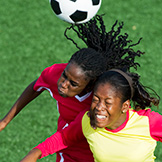By: Erin O'Tool, MD

Near the close of the 2015 FIFA Women’s World Cup, concussion in sport was once again thrust into the spotlight as two players at the height of their sport, Germany’s Alexandra Popp and USA’s Morgan Brain, had an incidental, but nonetheless violent and traumatic clash of heads which left one bloody and the other dazed.
Watching the injury unfold, as well as the management decisions that were made, left lingering questions about concussion, specifically in soccer, and how we can best work to minimize our risk of injury and maximize recovery.
Ask the Expert
How long does it take for concussion symptoms to appear—minutes, hours, days, months, years?
Part of what makes concussion diagnosis and management difficult is that there is so much variability in symptom onset. Some injuries will present immediately following contact. Others will remain relatively quiet for the first 24 hours and then become more pronounced.
The most important thing is to be aware of your body and of any abnormal symptoms that may develop, and knowing if those abnormalities could be a sign of a concussion.
What symptoms do physicians or athletic trainers look for or test immediately after contact to determine whether the individual can continue play?
The major signs and symptoms of concussive injury, especially immediately following injury, are confusion, headache, dizziness, poor memory and concentrations, as well as vision changes. Things to be concerned about immediately are severe headache, vomiting and loss of consciousness. Because concussions have such a variable onset, it is always better to be conservative and remove a player from play for further evaluation to assure the safety of the athlete
If an athlete experiences a head collision but does not have signs of a concussion, is there any reason they should sit out the next game?
Not all collisions cause concussions. That being said, it is often hard to tell if there is a concussion following the injury. This just exemplifies the importance of appropriate evaluation on the sidelines by coaches and training staff, and if there is any doubt, that the athlete get removed from play until they are appropriately evaluated by a health care professional.
What level of impact is considered safe? For soccer, is heading a ball considered a safe impact?
What constitutes a “safe head impact” actually is a difficult question to answer and one that researchers are actively debating and researching. Really the goal is to minimize head impacts, no matter the severity, with the thought that with recurrent impacts, there is a cumulative risk for long term damage.
This is a hot topic, specifically as it pertains to heading the ball in soccer. Some would argue that we should avoid headers under the age of 14 years. That has yet to be widely adopted but may have some merit as we move forward.
Are athletes more susceptible to a concussion after already having one or having another head injury?
While there is some argument in the medical field about this, it is generally accepted that after you suffered your initial injury, your threshold for subsequent concussive injury is lowered, and thus, you are at slightly higher risk for a second injury.
What can soccer players do specifically to prevent head injuries, collisions and overall concussions? Are there practice techniques or recommended head gear?
There are a number of things that can be done to help minimize risk of concussive injury. Primarily, it involves making sure you are playing without injury, have appropriate cardiovascular endurance for the sport you are participating in, and have good situational awareness to your surroundings. Additionally, using appropriate form for contact, be it or tackling, checking, or heading. At this time I would discourage the use of any additional head gear, as the research to support its use, at this time, is not terribly impressive.
What can coaches, trainers or parents of young athletes do to learn more about concussions? Are there specific certifications or training courses?
There is a wealth of information on the Internet that can help people learn more about the basics of concussion from multiple perspectives. I suggest referring to the following:
- Concussion Care Network
- Wisconsin Interscholastic Athletic Association (WIAA)
- HEADS UP to Youth Sports from the Centers for Disease Control & Prevention
More Information
Learn more about concussion testing and screening options available through our Concussion Care Network and sports medicine services.